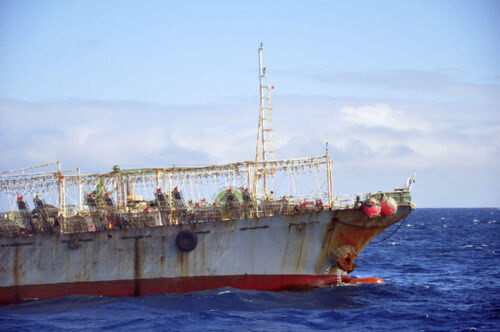 Christopher Ewell was an undergraduate student at New York University when he authored a publication on transshipment with Global Fishing Watch’s report, The Global View of Transshipment: Preliminary Findings, as an important source.
Christopher Ewell was an undergraduate student at New York University when he authored a publication on transshipment with Global Fishing Watch’s report, The Global View of Transshipment: Preliminary Findings, as an important source.
Is banning transshipment necessary to diminish illegal fishing? It is according to a recent publication in Marine Policy, titled Potential ecological and social benefits of a moratorium on transshipment on the high seas. The study’s author, Christopher Ewell used Global Fishing Watch’s recent report, The Global View of Transshipment: Preliminary Findings, to help validate his conclusions.
Ewell was an undergraduate student at New York University when he co-authored the paper, which compares international laws from different Regional Fisheries Management Organizations (RFMOs) on transhipment- the transfer of fish and supplies from one vessel to another in open waters. His main goal for the publication was to build social pressure against transshipment because of the multitude of criminal activities associated with it, including illegal, unreported, and unregulated (IUU) fishing and human trafficking, and to highlight the inadequacy of the current regulatory framework for transshipments on the high seas. While looking into data available on actual transshipments, he came across the Global Fishing Watch transshipment report.

From Ewell’s publication, Potential ecological and social benefits of a moratorium on transshipment on the high seas: Fig. 1. Transshipment At- Sea in the Seafood Supply Chain. (A) Legal (white) vessels and illegal (gray) vessels fishing on the high seas can (B) transship their catch to a (light gray) refrigerated cargo vessel and be refueled and resupplied, allowing them to stay at sea without returning to port. Legal and illegal catch are mixed aboard the cargo vessel, which then returns to offload at port along with legal fishing vessels (C), at which point inspection agents can no longer identify whether landed fish was legally or illegally caught. Illegal vessels can thus avoid returning to port for months or years at a time, and illegal fish is laundered into the seafood supply chain.)
“The conclusions in the report, particularly the relationship between IUU fishing and rendezvous, were incredibly valuable in terms of validating our claims. This finding suggests that transshipments may contribute to IUU fishing, which gave important support to our argument that a moratorium would reduce IUU fishing pressure,” he says.
Furthermore, the authors cited our finding that around 40 percent of transshipments occur on the high seas. Coupled with the limited legal framework and enforcement capability on the high seas, the findings support the idea of a need for a global transshipment moratorium, according to Ewell.
In addition, as part of their rebuttal to arguments put forth by industry that transshipment bans would have huge economic costs for fishing vessels, Ewell cited our finding that most high seas transshipments are clustered close to EEZ boundaries, not far into the high seas, and so rerouting vessels into EEZs would unlikely incur significant additional costs.


